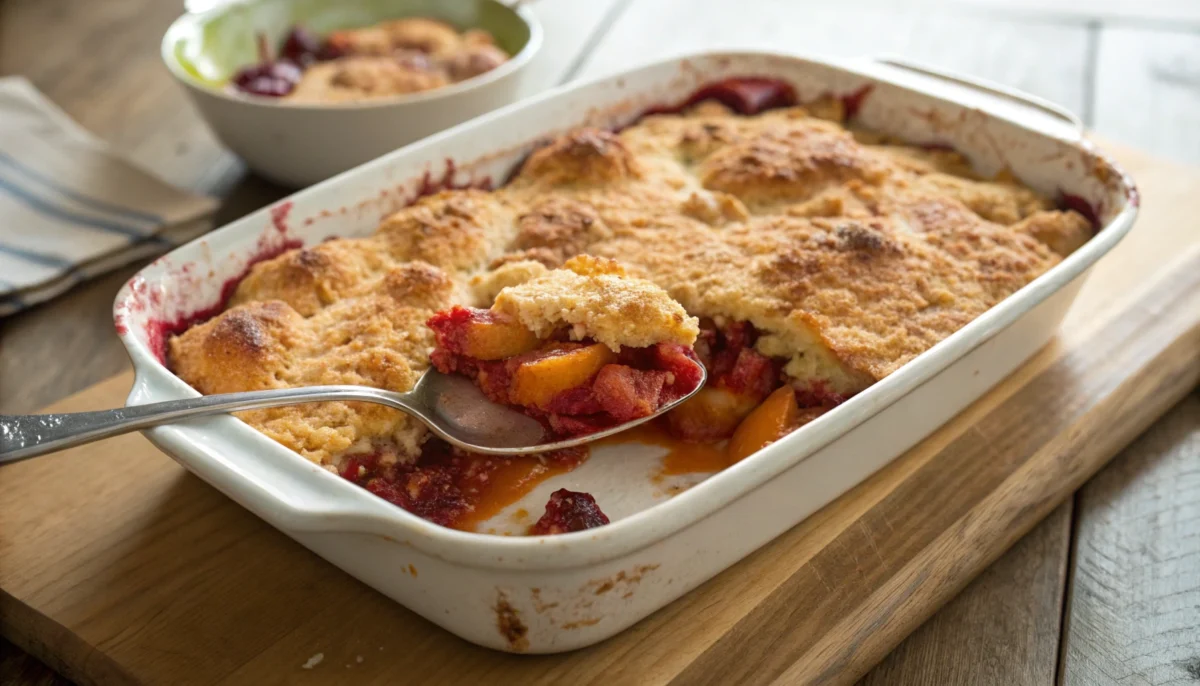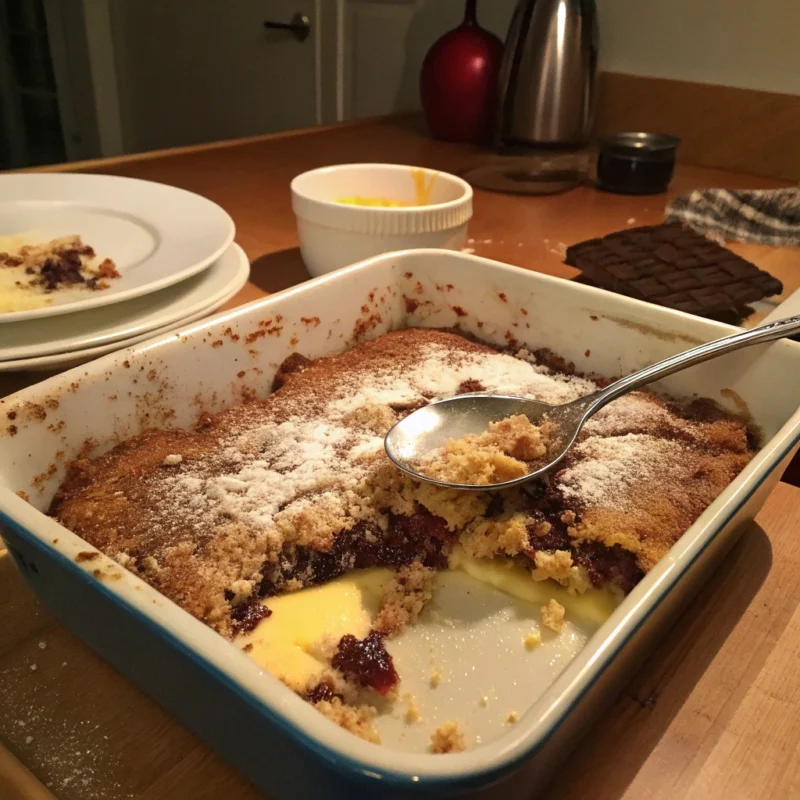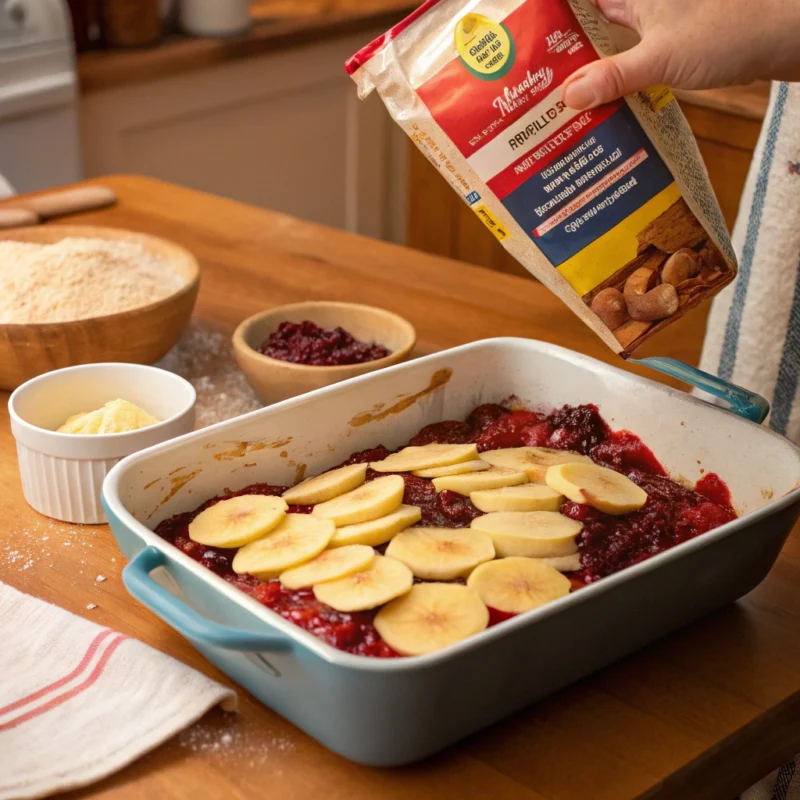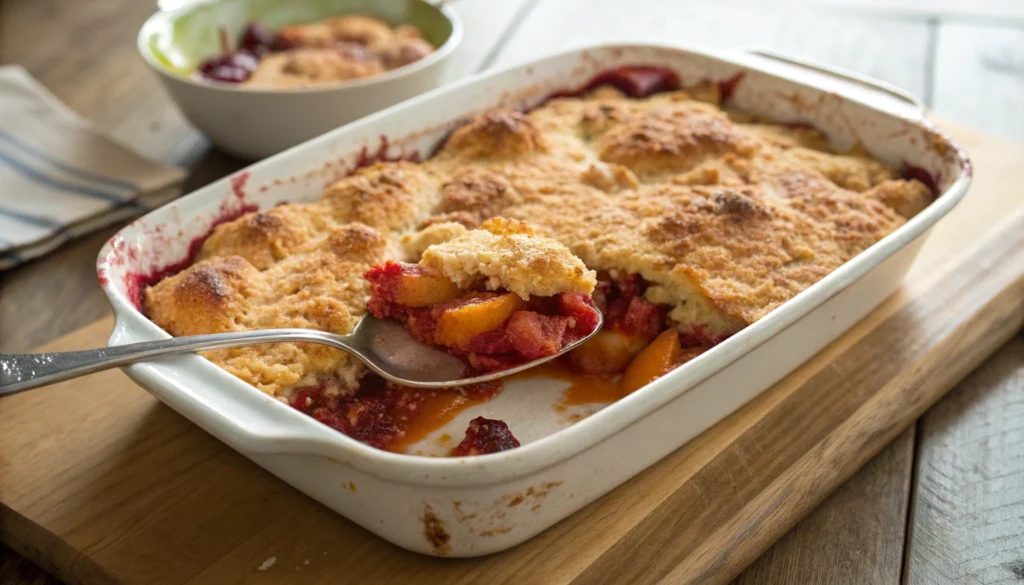
Introduction Biggest Mistake to Avoid When Making Dump Cake
Dump cakes are a dessert marvel, combining simplicity with delightful flavors. Known for their layered structure and fuss-free preparation, these cakes are loved for their no-fail charm. However, even the easiest recipes come with their pitfalls. This article dives deep into what is the biggest mistake to avoid when making a dump cake and provides a comprehensive guide to mastering this iconic dessert. From understanding the basics to avoiding common errors and elevating your dump cake game, we’ve got you covered!
Understanding Dump Cake Basics
What is a Dump Cake?
A dump cake is one of the easiest desserts to make—just layer the ingredients and bake! It’s called a “dump” cake because you literally dump the components, usually canned fruit, cake mix, and butter, into a baking dish without much mixing. The result? A luscious dessert with a golden, crumbly topping and fruity filling.
Origins and Popularity of Dump Cakes
Dump cakes trace their roots back to the mid-20th century when convenience foods were all the rage. They became popular as a quick and delicious way to satisfy a sweet tooth without hours in the kitchen. Over the years, dump cakes have retained their appeal due to their versatility—you can whip one up for family dinners, potlucks, or just about any gathering.
Why Dump Cakes Are a Favorite Dessert Choice
Dump cakes stand out for their effortless charm. No special equipment or advanced baking skills are needed. They’re also highly customizable—you can mix and match fruits, tweak the cake mix flavor, or add creative toppings. Whether you’re a baking novice or a seasoned pro, dump cakes deliver satisfying results without the stress.
This beloved dessert is proof that sometimes, the simplest recipes bring the most joy. With the right approach, your dump cake can go from good to unforgettable.
Common Mistakes Made While Preparing a Dump Cake

The Number One Rule: Don’t Stir!
When it comes to what is the biggest mistake to avoid when making a dump cake, stirring tops the list. While it might be tempting to mix the layers for even distribution, resist the urge. Stirring disrupts the distinct layers that are essential to this dessert’s texture and flavor.
The dry cake mix on top is designed to combine with the butter as it melts, creating a rich, crumbly topping. Stirring blends these elements prematurely, leaving you with a soggy or uneven mess. To avoid this, carefully layer your ingredients without mixing, letting the oven do the work.
Uneven Butter Distribution
Another common misstep is not spreading the butter evenly across the cake mix. Butter is the magic ingredient that turns dry cake mix into a golden, crispy crust. If you simply drop chunks of butter haphazardly, some areas might stay dry while others become overly greasy.
To get it right, slice the butter into thin pats or melt it and drizzle it evenly across the surface. Using a basting brush for melted butter can also help ensure every inch of the cake mix is covered.
Skipping the Grease
Forgetting to grease the baking dish is a rookie mistake that can lead to disaster. Dump cakes, with their buttery and sugary layers, are notorious for sticking to the pan. Skipping this step might leave you scraping the dessert off the dish instead of serving neat slices.
To prevent sticking, coat your dish with butter, non-stick spray, or parchment paper. A properly greased pan ensures a smooth release, making serving a breeze.
Using the Wrong Ingredients
The beauty of dump cakes lies in their adaptability, but not all substitutions work well. For instance, using canned fruit packed in heavy syrup can make the dessert overly sweet and sticky. Similarly, opting for dry or flavorless cake mix can lead to a bland outcome.
Choose high-quality ingredients for the best results. Fresh or frozen fruit can be a great alternative to canned varieties. And don’t shy away from experimenting with flavored cake mixes like spice, lemon, or chocolate to elevate the taste.
Balancing Fruit and Cake Mix
A delicate balance between the fruit filling and cake mix is crucial. Too little fruit, and your dump cake might turn out dry. Too much, and it becomes overly soggy. Aim for a ratio that lets the fruit shine without overwhelming the structure of the dessert.
By keeping these common mistakes in mind, you’ll avoid the pitfalls that can turn an otherwise delicious dump cake into a kitchen disaster. With these tips, you’re well on your way to mastering this classic treat.
How to Perfect Your Dump Cake Every Time
Choosing High-Quality Ingredients
The quality of your ingredients can make or break your dump cake. While this dessert is known for its simplicity, using fresh or premium items elevates its flavor and texture. Opt for frozen or fresh fruit instead of canned fruit packed in syrup to avoid excessive sweetness. If you prefer canned fruit, go for options in natural juice for a better balance of flavors.
When it comes to cake mix, consider experimenting with different flavors, like spice, chocolate, or lemon, depending on your fruit choice. A good-quality mix ensures a richer and more satisfying result.
Layering Techniques for Best Results

Achieving the perfect dump cake is all about how you layer the ingredients. Start by spreading the fruit evenly across the bottom of the greased baking dish. Ensure the layer is uniform so every bite has just the right amount of fruity goodness.
Next, sprinkle the dry cake mix over the fruit, making sure it covers the entire surface. Avoid compacting the mix—keeping it loose allows the butter to seep through and create the signature crumble topping. Finally, distribute the butter evenly. Thinly sliced pats of butter work best, as they melt uniformly and create a golden crust.
Tips for Adjusting Baking Time
Baking times can vary depending on your oven and the specific ingredients you use. Most dump cakes bake at 350°F (175°C) for 45-50 minutes, but it’s essential to keep an eye on it.
Signs your dump cake is done include a bubbling fruit layer around the edges and a golden-brown crust on top. If the cake looks too dry, you can add a little extra butter halfway through baking. Conversely, if the top starts browning too quickly, cover it loosely with foil to prevent burning.
Bonus Tip: Let It Rest
Once your dump cake is out of the oven, let it rest for at least 15 minutes before serving. This allows the layers to set and makes it easier to scoop or slice without the dessert falling apart.
By focusing on quality ingredients, proper layering, and careful baking, you’ll perfect your dump cake every time, leaving your guests impressed and your taste buds satisfied.
Creative Variations and Enhancements
Innovative Ingredient Combinations
The beauty of a dump cake lies in its versatility. By switching up the ingredients, you can transform this classic dessert into something unique and extraordinary. For instance, try replacing traditional cherry pie filling with tropical fruits like pineapple or mango for a summer-inspired treat. Want something indulgent? Combine chocolate cake mix with raspberries or caramelized bananas for a rich, decadent dessert.
Experimenting with spices is another way to elevate your dump cake. A sprinkle of cinnamon or nutmeg over apple filling creates a comforting, autumnal flavor. Similarly, adding a touch of ginger to peach filling adds a warm, spicy kick.
Toppings and Finishes
While the traditional dump cake needs no embellishments, a few thoughtful toppings can make it unforgettable. A dollop of whipped cream or a scoop of vanilla ice cream is a classic addition. For a more textured finish, sprinkle chopped nuts, shredded coconut, or even chocolate chips on top before baking.
Once out of the oven, drizzle caramel or chocolate sauce over the cake for a bakery-worthy presentation. These small touches enhance the flavor and make the dessert visually appealing—perfect for entertaining guests.
For More Delicious Ideas
For more dessert inspirations, check out the Perfect Peach Crumble Recipe on Makouri Recipes. It’s a delightful complement to dump cakes and equally easy to prepare!
By exploring creative combinations and finishes, you can take your dump cake to the next level, making it a dessert that’s both versatile and unforgettable.
FAQs About Dump Cake Mistakes
What is the Problem with Dump Cakes?
Dump cakes, while simple and convenient, can sometimes fall short due to common mistakes. One of the biggest challenges is uneven texture caused by improper layering or mixing ingredients. What is the biggest mistake to avoid when making a dump cake? Stirring the layers is a major culprit—it prevents the butter and cake mix from forming a proper crust. Additionally, forgetting to grease the pan or using overly sugary canned fruits can lead to sticking or an overly sweet result.
How Can You Tell When a Dump Cake is Done?
A perfectly baked dump cake has a golden-brown crust and bubbling fruit around the edges. The top should be crisp but not burned. Baking times vary, but most recipes take 45-50 minutes at 350°F (175°C). If you’re unsure, insert a toothpick into the topping—if it comes out clean or with just a few crumbs, the cake is done. Let the dessert cool slightly before serving to allow the layers to set properly.
Why is My Dump Cake Still Powdery?
A powdery top is often caused by uneven butter distribution. The butter should be spread or drizzled evenly across the dry cake mix to ensure it fully combines during baking. Thinly sliced pats of butter work well, or you can melt the butter and use a brush or spoon to cover every part of the surface. Skipping this step can leave parts of the mix dry and uncooked.
What Are the Three Common Causes of Failures in Cakes? Why?
- Improper Mixing: Overmixing or undermixing ingredients can affect the texture and consistency of any cake, including dump cakes.
- Incorrect Measurements: Using too much or too little of key ingredients, such as butter or fruit, can throw off the balance and lead to a dry or soggy cake.
- Inconsistent Baking Temperature: An uneven oven temperature can result in uneven cooking, with some parts undercooked and others burnt. Always preheat your oven and use a thermometer for accuracy.
By addressing these common issues, you can enjoy a flawless dump cake every time!
Below is the full summary of the content developed:
What is the Biggest Mistake to Avoid When Making a Dump Cake?
This comprehensive guide explored the art of making dump cakes, emphasizing the importance of avoiding common pitfalls like stirring, uneven butter distribution, and skipping essential preparation steps.
Key Highlights:
- Basics of Dump Cakes: What they are, their history, and why they’re so popular.
- Common Mistakes: Stirring the layers, using the wrong ingredients, or forgetting to grease the pan.
- Perfecting Techniques: How to choose quality ingredients, layer properly, and bake to golden perfection.
- Creative Variations: Innovative ingredient combinations, unique toppings, and ways to elevate this simple dessert.
- FAQs Answered: Addressing common concerns such as powdery results, knowing when a cake is done, and reasons cakes fail.
To Explore Further:
For more mouth-watering recipes, check out Perfect Peach Crumble Recipe on Makouri Recipes. It’s another easy and crowd-pleasing dessert to try!
If you’d like help generating a blog feature image or creating additional related content, feel free to ask.



